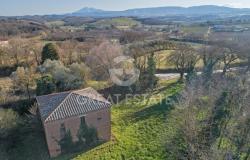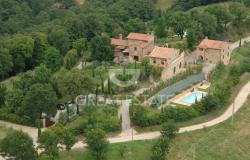Piedmont, Lombardy and Valle d'Aosta are located in the northwest corner of Italy, and are characterized by the contrast between the Alps and the plains, and the mixture of Italian and French as it borders with France and Switzerland.
Piedmont
While, much of Piedmont is mountainous, reaching up to the heights of Monte Rosa (4,633m), the region is really one of contrasts from its rolling vineyards to the mountain wonderland of the Gran Paradiso National Park and the verdant charms of Lago Maggiore.
Lowland Piedmont is a fertile agricultural region, producing wheat, rice and maize and is one of the great winegrowing regions in Italy. It produces wines such as Barbera, Barolo and Barbaresco, which are renowned for their depth, as well as the more approachable Dolcetto. Among the region's prized products are also truffles from the Alba area, cheeses such as Gorgonzola, Toma Piemontese and Grana Padano, and a delicious range of biscuits and chocolates. The region also has major industrial centres, with the FIAT car industry being the most famous.
Historically, Piedmont played a key role in shaping modern Italy. It provided the short-lived Kingdom of Italy with its monarchs, the Savoy family, and was the springboard for Italy's unification in 1859-1861, following earlier unsuccessful wars against Austria in 1820-1821 and 1848-1849.
Turin is the capital of the region and the great industrial, commercial and cultural centre around which much of the region's economy revolves. After many vicissitudes, in 1280, the city passed to the Savoys and in 1713 became the capital of the Kingdom of Sardinia and subsequently, until 1865, of the new Kingdom of Italy. The city has a wealth of monuments and historical buildings such as the famous medieval Palazzo Madama, a 13th - 14th centuries castle with a 1721 façade. Numerous fine buildings were built during the Baroque period when urban reorganization was planned by famous architects. Of that time are the Palazzo Reale, Castello del Valentino, Villa Reale at Stupinigi, the Superga basilica, the Gran Madre and Consolata churches and Piazza San Carlo. In the 18th century the tall bold Mole, symbol of the city, was created by Antonelli.The other main cities of the Piedmont region are the provincial capitals (Alessandria, Asti, Biella, Cuneo, Novara, Vercelli, Verbania and Torino), and Moncalieri and Rivoli.
Being home to the Savoy dynasty that reigned as Italy's royal family, Turin shares a culinary tradition with neighbouring France. However, the region is mostly renown for its hill country cooking. In autumn, the region offers excellent game, mushrooms and white truffles, whose magical aromas enhance pastas and risottos, meats and cheeses. Pastas are dominated tajarin and agnolotti and the plane near the river Po around Vercelli and Novara are Europe's leading suppliers of rice, especially the prized Carnaroli variety.
The region breeds prized beef of the razza piemontese which are then cooked braised in red wine, roasted, grilled or simmered as the base of bollito misto. The region produces quantities of Gorgonzola from Novara, as well as Taleggio and Grana Padano, DOP cheeses also produced in other regions and local cheeses protected by DOP such as Robiola di Roccaverano, Murazzano and Brà´s. Piedmont is a also major producer of hazelnuts, protected under IGP (Indicazione Geografica Protetta (Protected Geographical Origin).
Most of the wines in Piedmont are produced on family estates made up of relatively small vineyards and the region boasts the greatest number of classified wines in Italy with with 46 different DOC (Denominazione di Origine Controllata - Controlled Denomination of Origin) and four DOCG (Denominazione di Origine Controllata e Guarantita - Controlled and Guaranteed Denomination of Origin) areas, accounting for more than half of its 170,000 acres of vineyards. It produces the largest number of best known, noble, and world-appreciated prize-winning wines, such as Barbera, Barolo, Barbaresco, Grignolino, Dolcetto, Nebbiolo, Malvasia, Moscato d'Asti and Asti Spumante among others. Moreover, Turin is the capital of vermouth, which is fortified wine flavored with herbs and spices.
Lombardy
Lombardy (Lombardia) stretches from the border with Switzerland and the Stelvio National Park, down through the stunning lakes of Lago di Como, Lago Iseo, Lago Maggiore and Lago di Garda, and on to the plain of the River Po. It is one the wealthiest Italian regions known as the center of Italian fashion, commerce, and industry.
Lombardy's regional capital is Milan, which has long been an important trading centre at the junction of transalpine routes and continues to be the centre of business and finance.
The main land marks of the city are the Gothic Duomo, the Castello Sforzesco and the Teatro alla Scala. Art-lovers will not want to miss the masterpieces in the city's galleries, the most famous is the Pinacoteca di Brera where you find paintings Raffaello, Piero della Francesca, Mantegna, Modigliani, Carrà . In addition, the church of Santa Maria delle Grazie boast Leonardo's second most famous painting (after the Mona Lisa) the Last Supper. Via Monte Napoleone is famous for its line up of top designers shops like Armani, Prada, Valentino, Gucci, Versace, Ferragamo, Trussardi, etc.
The region's other provinces are: Lecco, Varese, Como, Bergamo, Sondrio, Brescia, Cremona, Mantova, Pavia and Lodi.
Lombardy's cuisine includes dishes such as risotto alla milanese, frogs (in Pavia), ossobuco alla milanese, bresaola, polenta and the now nationally acclaimed Christamas sweet Il Panettone. Milan's gastronomic traditions is varied and influenced by the varied territory that extends from the Alps along the lakes of Garda, Como and Maggiore across the Po plains to the Apennines. Risotto and polenta play a central role in local cuisine. The typical use of butter, cream and lard has only gradually left its place to olive oil in cooking.
Lombardy's popular cheeses include Grana Padano, Gorgonzola, Taleggio, Quartirolo Lombardo and tangy Provolone Valpadano, all covered by DOP, as well as Robiola and Stracchino.
In Lombardy two wines have been distinguished as DOCGs, these are Franciacorta, a sparkling wine made by the classical method of fermentation in bottle, and Valtellina Superiore, a red from Nebbiolo. Particularly interesting among the regional 13 DOCs are those of Oltre Pavese, which include a range of reds, whites and sparkling wines, and Lugana, which is a fruity white produced in the south of Lake Garda.
Valle D'Aosta
Valle d'Aosta is the smallest Italian region, and lies on the border of Italy with France and Switzerland. It is mostly mountainous with the highest peaks in Europe (Monte Bianco, Cervino, Monte Rosa, Gran Paradiso). It is also famous for its beautiful green valleys on the sides of the long Dora Baltea river.
Agriculture is mostly based on vineyards, and the breeding of cows allows a rich production of milk and cheese; What the region is perhaps most famous for are its excellent valleys and mountains which in winter welcome thousands of skiers while in summer provide refuge for those looking for a holiday away from the seaside. In particular the village of Courmayeur is held in high esteem amongst skiers. The region is also famous for its astounding medieval castles, usually built on top of high rocks, 70 of which have, in some form or another, survived the odds of time.
Aosta, the regional capital, lies on a plain surrounded by mountains, it is also known as the "Rome of the Alps" for the fine Roman ruins that are still a reminder of the times when the city, was built in honor of Emperor Augustus and called Augusta Praetoria.
The region has a robust cuisine based on cheese and meat, rye bread, potatoes, polenta, risotto and soups. Among the local cheeses the toma, the Robiola and above all Fontina DOP are notable and figure in many a dish, including fondua, made with milk.
Meat specialties of Valle d'Aosta are the beef stew called carbonade and breaded veal cutlets or costolette. Hunting is limited, but game includes partridge, grouse, hare, venison, as well as chamois and ibex.
The region has one DOC denomination that covers a total of 25 different styles of wine, both varietals, such as the Chardonnay or Pinot Noir, and seven geographically designated sub-zones: Arnad-Motjovet, Arvier, Chambave, Donnas, Mergex / La Salle, Nus, and Torrette.
Meals are typically concluded with the passing of the grolla, a pot containing caffè valdostana (coffee with red wine, grappa and lemon peel), which is sipped from numerous spouts.








